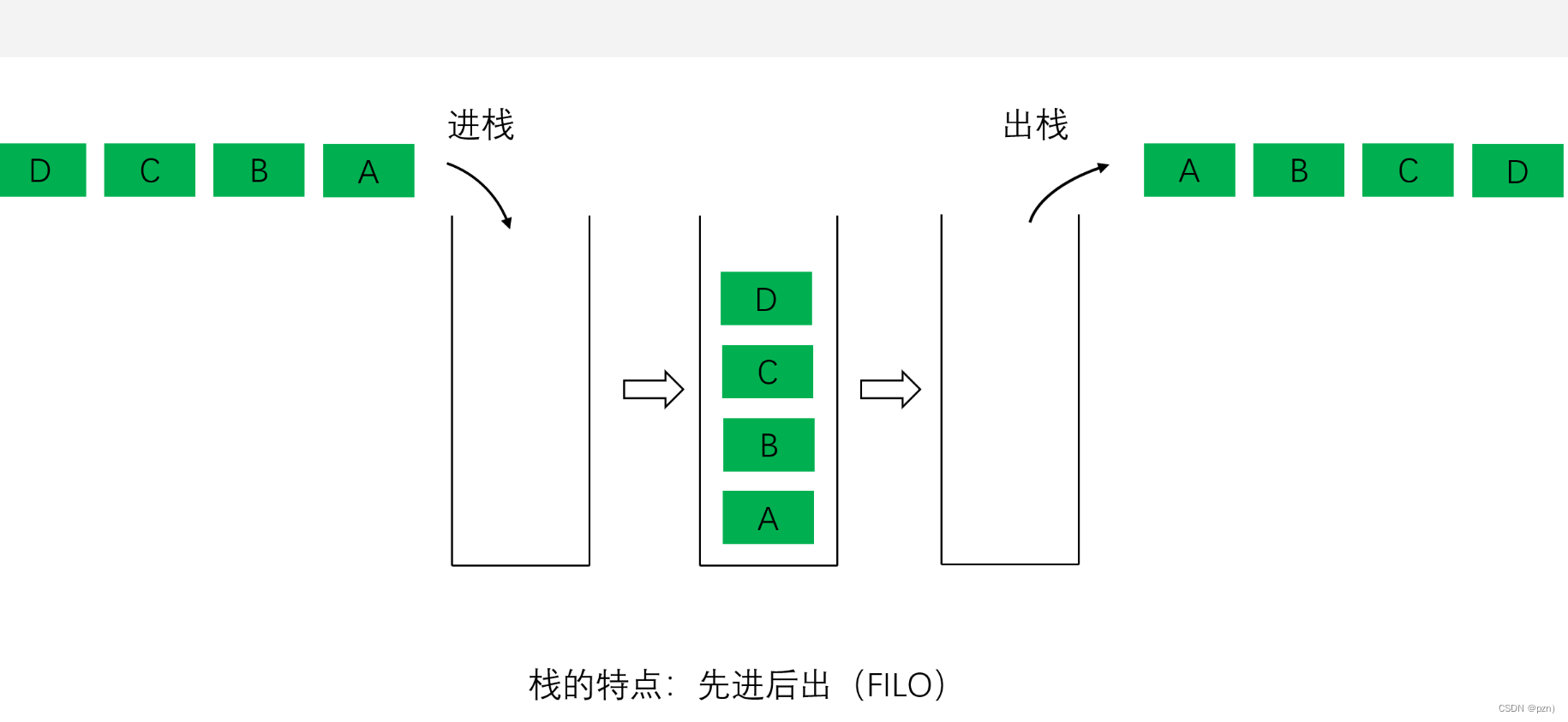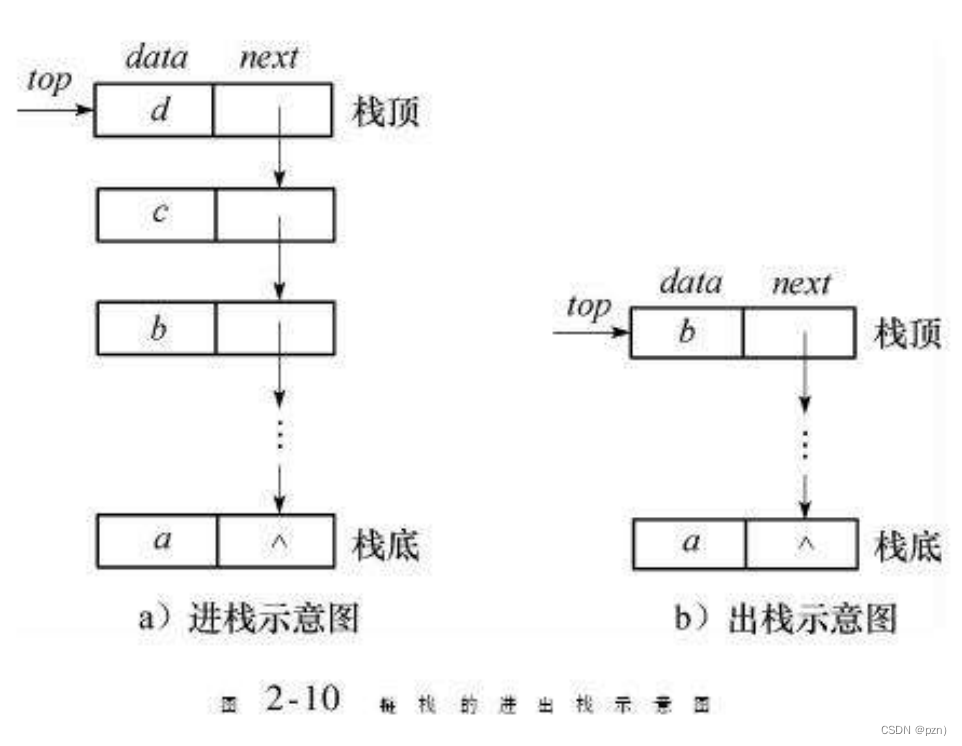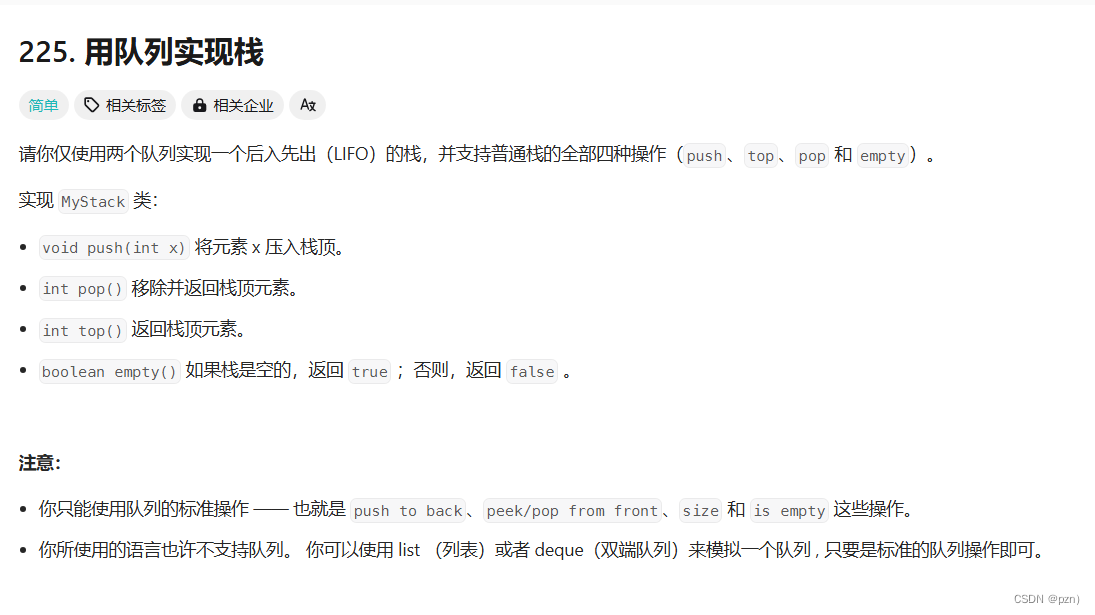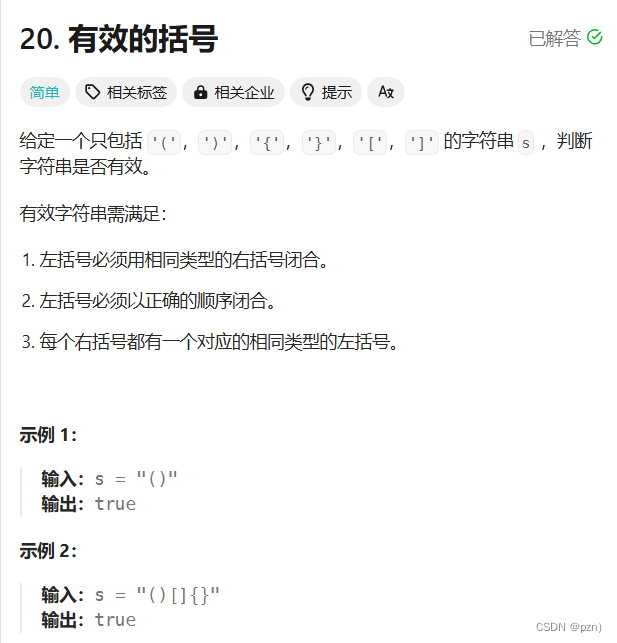目录
[2. 用队列实现栈](#2. 用队列实现栈)
1.栈
1.1****栈的概念及结构
栈:一种特殊的线性表,其只允许在固定的一端进行插入和删除元素操作。 进行数据插入和删除操作的一端
称为 栈顶 ,另一端称为 栈底 。 栈中的数据元素遵守后进先出 LIFO ( Last In First Out )的原则。
压栈 :栈的插入操作叫做进栈 / 压栈 / 入栈, 入数据在栈顶 。
出栈 :栈的删除操作叫做出栈。 出数据也在栈顶 。


1.2****栈的实现
栈的实现一般可以使用 数组或者链表实现 ,相对而言数组的结构实现更优一些。因为数组在尾上插入数据的代价比较小。


#include"Queue.h"
//初始化
void QueueInit(Queue* pq)
{
assert(pq);
pq->phead = NULL;
pq->ptail = NULL;
pq->size = 0;
}
//销毁
void QueueDestroy(Queue* pq)
{
assert(pq);
QNode* cur = pq->phead;
while (cur)
{
QNode* next = cur->next;
free(cur);
cur = next;
}
pq->phead = pq->ptail = NULL;
pq->size = 0;
}
// 队尾插入
void QueuePush(Queue* pq, QDataType x)
{
assert(pq);
QNode* newnode = (QNode*)malloc(sizeof(QNode));
if (newnode == NULL)
{
perror("malloc fail");
return;
}
newnode->next = NULL;
newnode->val = x;
if (pq->ptail == NULL)
{
pq->phead = pq->ptail = newnode;
}
else
{
pq->ptail->next = newnode;
pq->ptail = newnode;
}
pq->size++;
}
// 队头删除
void QueuePop(Queue* pq)
{
assert(pq);
assert(pq->size != 0);
//一个节点
if (pq->phead->next == 0)
{
free(pq->phead);
pq->phead = pq->ptail = NULL;
}
//多个节点
else
{
QNode* next = pq->phead->next;
free(pq->phead);
pq->phead = next;
}
pq->size--;
}
// 取队头和队尾的数据
QDataType QueueFront(Queue* pq)
{
assert(pq);
assert(pq->phead);
return pq->phead->val;
}
QDataType QueueBack(Queue* pq)
{
assert(pq);
assert(pq->ptail);
return pq->ptail->val;
}
int QueueSize(Queue* pq)
{
assert(pq);
return pq->size;
}
//判空
bool QueueEmpty(Queue* pq)
{
assert(pq);
return pq->size == 0;
}2.队列
2.1****队列的概念及结构
队列:只允许在一端进行插入数据操作,在另一端进行删除数据操作的特殊线性表,队列具有先进先出 FIFO(First In First Out)
入队列:进行插入操作的一端称为队尾
出队列:进行删除操作的一端称为队头

2.2队列的实现
队列也可以数组和链表的结构实现,使用链表的结构实现更优一些,因为如果使用数组的结构,出队列在数组头上出数据,效率会比较低。

#include"Queue.h"
//初始化
void QueueInit(Queue* pq)
{
assert(pq);
pq->phead = NULL;
pq->ptail = NULL;
pq->size = 0;
}
//销毁
void QueueDestroy(Queue* pq)
{
assert(pq);
QNode* cur = pq->phead;
while (cur)
{
QNode* next = cur->next;
free(cur);
cur = next;
}
pq->phead = pq->ptail = NULL;
pq->size = 0;
}
// 队尾插入
void QueuePush(Queue* pq, QDataType x)
{
assert(pq);
QNode* newnode = (QNode*)malloc(sizeof(QNode));
if (newnode == NULL)
{
perror("malloc fail");
return;
}
newnode->next = NULL;
newnode->val = x;
if (pq->ptail == NULL)
{
pq->phead = pq->ptail = newnode;
}
else
{
pq->ptail->next = newnode;
pq->ptail = newnode;
}
pq->size++;
}
// 队头删除
void QueuePop(Queue* pq)
{
assert(pq);
assert(pq->size != 0);
//一个节点
if (pq->phead->next == 0)
{
free(pq->phead);
pq->phead = pq->ptail = NULL;
}
//多个节点
else
{
QNode* next = pq->phead->next;
free(pq->phead);
pq->phead = next;
}
pq->size--;
}
// 取队头和队尾的数据
QDataType QueueFront(Queue* pq)
{
assert(pq);
assert(pq->phead);
return pq->phead->val;
}
QDataType QueueBack(Queue* pq)
{
assert(pq);
assert(pq->ptail);
return pq->ptail->val;
}
int QueueSize(Queue* pq)
{
assert(pq);
return pq->size;
}
//判空
bool QueueEmpty(Queue* pq)
{
assert(pq);
return pq->size == 0;
}**3.**栈和队列经典题目
1.括号匹配问题
思路:(C语言)
利用已经实现好的栈
每个左括号要跟离自己最近的右括号匹配
左括号,入栈
右括号,取栈顶判断是否匹配
/*给定一个只包括 '(',')','{','}','[',']' 的字符串 s ,判断字符串是否有效。
有效字符串需满足:
左括号必须用相同类型的右括号闭合。
左括号必须以正确的顺序闭合。
每个右括号都有一个对应的相同类型的左括号。*/
#include<stdio.h>
#include<stdbool.h>
typedef char STDataType;
typedef struct Stack
{
STDataType* a;
int top;
int capacity;
}ST;
//初始化
void STInit(ST* pst)
{
assert(pst);
pst->a = NULL;
//top指向栈顶数据的下一个位置
pst->top = 0;
//top指向栈顶数据
//pst->top = -1;
pst->capacity = 0;
}
//销毁
void STDestroy(ST* pst)
{
assert(pst);
free(pst->a);
pst->a = NULL;
pst->top = pst->capacity = 0;
}
//入栈
void STpush(ST* pst, STDataType x)
{
assert(pst);
//扩容
if (pst->top == pst->capacity)
{
int newcapacity = pst->capacity == 0 ? 4 : pst->capacity * 2;//三目操作符,如果pst->capacity等于0:赋4,不等于:扩容2倍
STDataType* tmp = (STDataType*)realloc(pst->a, newcapacity * sizeof(STDataType));
if (tmp == NULL)
{
perror("realloc fail");
return;
}
pst->a = tmp;
pst->capacity = newcapacity;
}
pst->a[pst->top] = x;
pst->top++;
}
//出栈
void STPop(ST* pst)
{
assert(pst);
assert(pst->top > 0);
pst->top--;//直接覆盖
}
//取栈顶数据
STDataType STTop(ST* pst)
{
assert(pst);
assert(pst->top > 0);
return pst->a[pst->top - 1];
}
//判空
bool STEmpty(ST* pst)
{
assert(pst);
return pst->top == 0;
}
//获取数据个数
int STSize(ST* pst)
{
assert(pst);
return pst->top;
}
//每个左括号要跟离自己最近的右括号匹配
//左括号,入栈
//右括号,取栈顶判断是否匹配
bool isValid(char* s) {
ST st;
STInit(&st);
while (*s)
{
//左括号入栈
if (*s == '(' || *s == '[' || *s == '{')
{
STpush(&st, *s);
}
else//右括号
{
if (STEmpty(&st))//判空
{
STDestroy(&st);//空,销毁,返回false
return false;
}
char top = STTop(&st);//取栈顶顶数据
STPop(&st);//出栈
//不匹配
if ((top == '(' && *s != ')')
|| (top == '{' && *s != '}')
|| (top == '[' && *s != ']'))
{
STDestroy(&st);
return false;
}
}
++s;
}
//栈不为空,说明左括号比右括号多,数量不匹配
bool ret = STEmpty(&st);
STDestroy(&st);
return ret;
}2. 用队列实现栈

利用两个队列
把队尾前面全部数据给到另一个队列,就能取到队尾相当于栈顶的数据
typedef int QDataType;
typedef struct QueueNode
{
struct QueueNode* next;
QDataType val;
}QNode;
typedef struct Queue
{
QNode* phead;
QNode* ptail;
int size;
}Queue;
void QueueInit(Queue* pq);
void QueueDestroy(Queue* pq);
// 队尾插入
void QueuePush(Queue* pq, QDataType x);
// 队头删除
void QueuePop(Queue* pq);
// 取队头和队尾的数据
QDataType QueueFront(Queue* pq);
QDataType QueueBack(Queue* pq);
int QueueSize(Queue* pq);
//判空
bool QueueEmpty(Queue* pq);
//初始化
void QueueInit(Queue* pq)
{
assert(pq);
pq->phead = NULL;
pq->ptail = NULL;
pq->size = 0;
}
//销毁
void QueueDestroy(Queue* pq)
{
assert(pq);
QNode* cur = pq->phead;
while (cur)
{
QNode* next = cur->next;
free(cur);
cur = next;
}
pq->phead = pq->ptail = NULL;
pq->size = 0;
}
// 队尾插入
void QueuePush(Queue* pq, QDataType x)
{
assert(pq);
QNode* newnode = (QNode*)malloc(sizeof(QNode));
if (newnode == NULL)
{
perror("malloc fail");
return;
}
newnode->next = NULL;
newnode->val = x;
if (pq->ptail == NULL)
{
pq->phead = pq->ptail = newnode;
}
else
{
pq->ptail->next = newnode;
pq->ptail = newnode;
}
pq->size++;
}
// 队头删除
void QueuePop(Queue* pq)
{
assert(pq);
assert(pq->size != 0);
//一个节点
if (pq->phead->next == 0)
{
free(pq->phead);
pq->phead = pq->ptail = NULL;
}
//多个节点
else
{
QNode* next = pq->phead->next;
free(pq->phead);
pq->phead = next;
}
pq->size--;
}
// 取队头和队尾的数据
QDataType QueueFront(Queue* pq)
{
assert(pq);
assert(pq->phead);
return pq->phead->val;
}
QDataType QueueBack(Queue* pq)
{
assert(pq);
assert(pq->ptail);
return pq->ptail->val;
}
int QueueSize(Queue* pq)
{
assert(pq);
return pq->size;
}
//判空
bool QueueEmpty(Queue* pq)
{
assert(pq);
return pq->size == 0;
}
//利用两个队列
//把队尾前面全部数据给到另一个队列,就能取到队尾相当于栈顶的数据
typedef struct {
Queue q1;
Queue q2;
} MyStack;
//初始化
MyStack* myStackCreate() {
MyStack* pst=(MyStack* )malloc(sizeof(MyStack));
QueueInit(&(pst->q1));
QueueInit(&(pst->q2));
return pst;
}
//将元素 x 压入栈顶。
void myStackPush(MyStack* obj, int x) {
//两个队列哪个不为空就插入哪个
if(!QueueEmpty( &(obj->q1) ) )
{
QueuePush(&(obj->q1),x);
}
else
{
QueuePush(&(obj->q2),x);
}
}
//移除并返回栈顶元素。
int myStackPop(MyStack* obj) {
//假设法
Queue* empty=&(obj->q1);
Queue* nonEmpty=&(obj->q2);
if(!QueueEmpty(&(obj->q1)))
{
empty=&(obj->q2);
nonEmpty=&(obj->q1);
}
//不为空前size-1导走,删除最后一个就是栈顶数据
while(QueueSize(nonEmpty)>1)
{
QueuePush(empty,QueueFront(nonEmpty));
QueuePop(nonEmpty);
}
int top=QueueFront(nonEmpty);
QueuePop(nonEmpty);
return top;
}
//返回栈顶元素
int myStackTop(MyStack* obj) {
if(!QueueEmpty(&(obj->q1)))
{
return QueueBack(&(obj->q1));//去队尾数据
}
else
{
return QueueBack(&(obj->q2));
}
}
//如果栈是空的,返回 true ;否则,返回 false 。
bool myStackEmpty(MyStack* obj) {
return QueueEmpty(&(obj->q1)) && QueueEmpty(&(obj->q2));
}
//销毁
void myStackFree(MyStack* obj) {
QueueDestroy(&(obj->q1));
QueueDestroy(&(obj->q2));
free(obj);
}感谢观看
